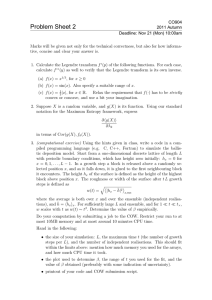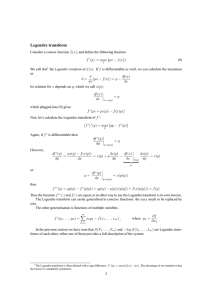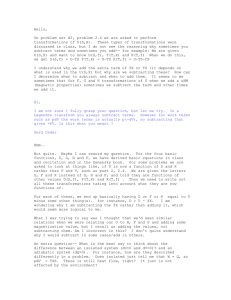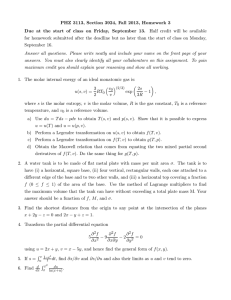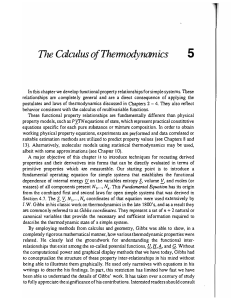Supplementary Notes for Chapter 5 The Calculus of Thermodynamics
advertisement
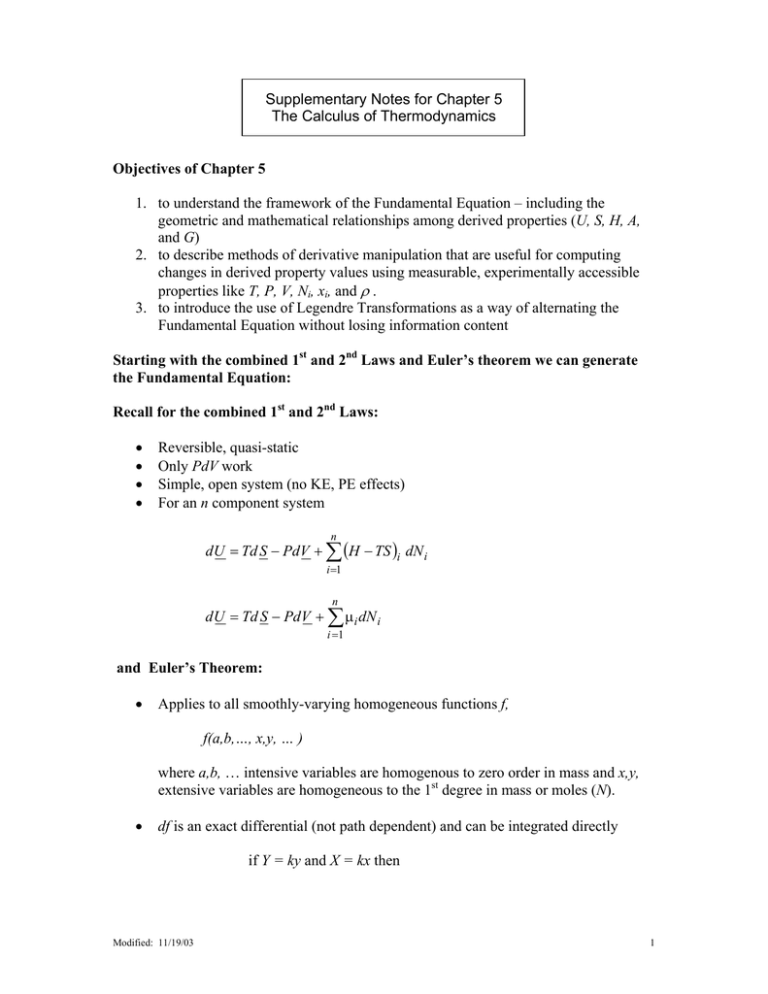
Supplementary Notes for Chapter 5 The Calculus of Thermodynamics Objectives of Chapter 5 1. to understand the framework of the Fundamental Equation – including the geometric and mathematical relationships among derived properties (U, S, H, A, and G) 2. to describe methods of derivative manipulation that are useful for computing changes in derived property values using measurable, experimentally accessible properties like T, P, V, Ni, xi, and ρ . 3. to introduce the use of Legendre Transformations as a way of alternating the Fundamental Equation without losing information content Starting with the combined 1st and 2nd Laws and Euler’s theorem we can generate the Fundamental Equation: Recall for the combined 1st and 2nd Laws: • • • • Reversible, quasi-static Only PdV work Simple, open system (no KE, PE effects) For an n component system n dU = Td S − PdV + ∑ (H − TS )i dN i i =1 n d U = Td S − PdV + ∑ µ i dN i i =1 and Euler’s Theorem: • Applies to all smoothly-varying homogeneous functions f, f(a,b,…, x,y, … ) where a,b, … intensive variables are homogenous to zero order in mass and x,y, extensive variables are homogeneous to the 1st degree in mass or moles (N). • df is an exact differential (not path dependent) and can be integrated directly if Y = ky and X = kx then Modified: 11/19/03 1 f(a,b, …, X,Y, …) = k f(a,b, …, x,y, …) and ⎛ ∂f ⎞ ⎛ ∂f ⎞ x⎜ ⎟ + ... = (1) f (a, b,...x, y,...) + y⎜⎜ ⎟⎟ ⎝ ∂x ⎠ a,b,..., y ,.. ⎝ ∂y ⎠ a,b,.., x,.. Fundamental Equation: • Can be obtained via Euler integration of combined 1st and 2nd Laws • Expressed in Energy (U) or Entropy (S) representation n U = f u [S , V , N1 , N 2 ,..., N n ] = T S − PV + ∑ µ i N i i =1 or S = f s [U , V , N1 , N 2 ,..., N n ] = n µ U P + V − ∑ i Ni T T i =1 T The following section summarizes a number of useful techniques for manipulating thermodynamic derivative relationships Consider a general function of n + 2 variables F ( x, y,z3 ,...,zn + 2 ) where x ≡ z1, y ≡ z2. Then expanding via the rules of multivariable calculus: n+ 2 ⎛ ∂F ⎞ dF = ∑ ⎜ ⎟dzi i =1 ⎝ ∂zi ⎠ Now consider a process occurring at constant F with z3, .., zn+2 all held constant. Then ⎛ ∂F ⎞ ⎛ ∂F ⎞ dF = 0 = ⎜ dx + ⎜ dy ⎟ ⎟ ⎝ ∂x ⎠ y ,z3 ,... ⎝ ∂y ⎠ x ,z3 ,... 2 Rearranging, we get: Triple product “x-y-z-(-1) rule” for F(x,y): (∂F / ∂x ) y (∂x / ∂y )F (∂y / ∂F )x = −1 example: (∂H / ∂T )P (∂T / ∂P )H (∂P / ∂H )T = −1 Add another variable to F(x,y): (∂F / ∂y )x = (∂F / ∂φ)x (∂y / ∂φ)x example: F ( x, y ) = S ( P, H ) and φ = T then (∂S / ∂T )P C p / T ⎛ ∂S ⎞ = = 1/ T ⎜ ⎟ = Cp ⎝ ∂H ⎠ P (∂H / ∂T )P Derivative inversion for F(x,y): example: (∂F / ∂y )x = 1 / (∂y / ∂F )x (∂T / ∂S )P = 1 / (∂S / ∂T )P = T / C p Maxwell’s reciprocity theorem: Applies to all homogeneous functions, e.g. F(x,y, ..) ⎢ ∂ (∂F / ∂x) y ,... ⎥ ⎢ ∂ (∂F / ∂y ) x,... ⎥ ⎥ =⎢ ⎢ ⎥ or Fxy = F yx dy ∂x ⎦ y ,.. ⎦ x,.. ⎣ ⎣ example: n d U = Td S − PdV + ∑ µ i dN i i =1 (∂T / ∂V ) S , N = U S V = U SV = −(∂P / ∂ S )V , N = U V S = U VS 3 Legendre Transforms: ( xi , ξ i ) (S , T ) (V , − P) (Ni , µi ) ( x i , Fi ) ( a , σ) (extensive, intensive) General relationship ⎫ ⎪ ⎪ ⎪⎪ ⎬ ⎪ ⎪ ⎪ ⎪⎭ Conjugate coordinates Examples y ( 0) = f [ x1 ,..., x m ] (basis function) U = f [ S , V , N1 ,... N n ] k y ( k ) = y ( 0) − ∑ ξi xi (k th transform) y (1) = A = U − T S i =1 or by changing variable order to U = f (V, S, N1,…,Nn), y (1) = H = U + PV 4 General relationship dy (k ) k = −∑ xi dξ i + i =1 Examples m ∑ ξ i dxi dy (1) i = k +1 n ≡ d A = − SdT − PdV + ∑ µ i dN i i =1 or dy (1) n ≡ d H = Td S + V dP + ∑ µ i dN i i =1 y ( m) =y ( 0) m − ∑ ξ i xi = 0 y ( n + 2) = 0 (total transform with m = n + 2) i =1 m n dy ( m) = −∑ xi dξ i = 0 dy ( n+ 2) = − SdT + V dP − ∑ N i dµ i = 0 i =1 i =1 (Gibbs-Duhem Equation) Relationships among Partial Derivatives of Legendre Transforms yij( k ) = y (jik ) = y1(i0) = 2 (0) ∂ y ∂x1∂xi ∂ 2 y (k ) ∂xi ∂x j (Maxwell relation) ( 0) = y11 2 ∂ y ⎛ ∂y ( 0) ⎞ ⎟ ξ i ≡ yi(0) = ⎜ ⎜ ∂x ⎟ i ⎠ x j [i ] ⎝ ⎧⎪− xi i = 1 ⎫⎪ yi(1) = ⎨ ⎬ ⎪⎩ ξi i > 1⎪⎭ ( 0) ∂x12 [ NB : ξi = yi( 0) as well for i > 1] 5 Reordering and Use of Tables 5.3-5.5 (1) Table 5.3 – 2nd & 3rd order derivatives of [ yij(1) and yijk ] in terms of yii(0) , etc Table 5.4 – Relations between 2nd order derivatives of jth Legendre transform y ik( j ) and the basis function y ik(0) Table 5.5 – Relationships among 2nd order derivatives of jth Legendre transform yik( j ) to 12 (j-q) transform y ik( j −q ) \10.40\Ch5-Calc. of Thermo. Suppl. Notes 2 Modified: 11/19/03 6
